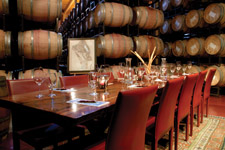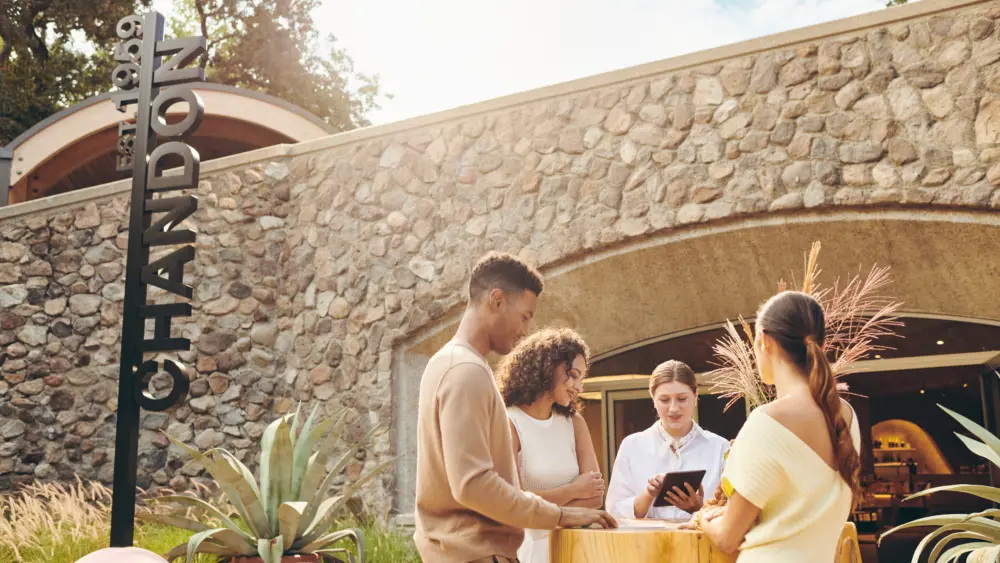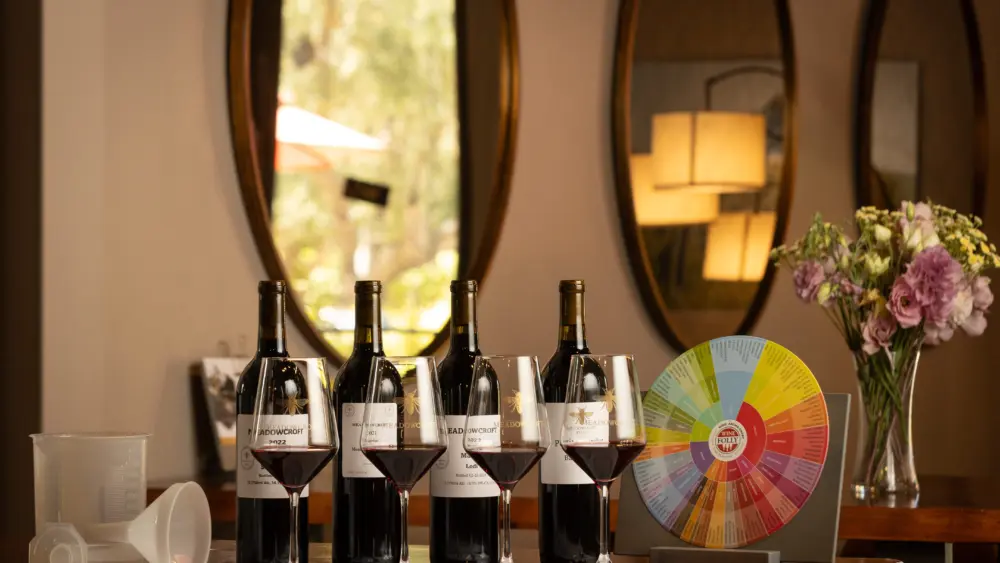Chappellet Winery
1581 Sage Canyon Road
St. Helena, CA 94574
(707) 963-7136
www.chappellet.com
Hours: By appointment daily
Fees: Tour and tasting: $35; tasting only: $25
Varietals produced: Cabernet Sauvignon, Merlot, Cabernet Franc, Malbec, Petite Sirah, Zinfandel, Chardonnay, Chenin Blanc
Picnics: Wine club members only
Did You Know?
Chappellet was the second newly constructed winery built in Napa since before prohibition (Robert Mondavi’s was the first, in 1966).
When I visited Chappellet Winery in late July, I reached the east Napa area a bit early. So I stopped at Lake Hennessey’s boat launch nearby. The first thing that caught my eye was a huge bird, coasting over the glassy water toward the reed-lined shore. I soon realized it was a great blue heron, a male, and he was flying to land near a female perched onshore. When he landed, he began to dance for her. His wings spread out as he pranced and he moved his neck back and fourth in a rhythmic motion. He did spins and sang to her—all while she acted like it was no big deal. And that’s when I realized that part of the joy of visiting Chappellet is the journey there.
I eventually headed toward the long, winding drive that leads past the hillside vineyards and homesteads, up to the winery that’s perched atop Pritchard Hill. Next to a parking lot shaded with old-growth trees is a pathway that winds up to the winery’s entrance, a double doorway that’s framed in wood and looks like someone’s beautiful, welcoming front porch. And that it is.
 Once inside, there’s a foyer where visitors are warmly greeted by the hospitality staff, and the journey begins. First, you’ll learn some property and family history. And you’ll soon realize that this place is all about family, good friends and great wine.
Once inside, there’s a foyer where visitors are warmly greeted by the hospitality staff, and the journey begins. First, you’ll learn some property and family history. And you’ll soon realize that this place is all about family, good friends and great wine.Molly and Donn Chappellet met when they were in grade school and married while in college. This year, they’ll celebrate six decades of marriage. They first visited California Wine Country in the late 1950s—Wente Vineyards in Livermore and Beaulieu Vineyards in Napa (among others). Donn had been collecting first-growth Bordeaux (Château LaTour, Châteaux Margaux and Château Lafite Rothchild), and he wanted to make wines like those.
He phoned Beaulieu winemaker André Tchelistcheff for advice about where to buy land to grow grapes that would make a wine equivalent to what he’d tasted. They spoke about characteristics of the wine Donn wanted to make, and Tchelistcheff soon realized that Donn wanted mountain fruit—from there, the search began in earnest. Pritchard Hill was the first property he saw. He continued to look, but couldn’t get its beauty out of his mind. In 1967, Donn and Molly purchased half the property (they bought the other half one year later).
There are 640 acres total, and more than 500 remain untouched. The rest consist of the Chappellet’s family home, the winery facilities and 100 acres of Cabernet Sauvignon, Cabernet Franc, Merlot, Petit Verdot and Malbec—the five classic Bordeaux varietals. There are also three acres of Chenin Blanc (a varietal that had been part of the original plantings and that remains near and dear to the family’s heart). Most of the vineyard is made up of California-certified organically farmed grapes.
The first official vintage was 1969 (you can see a bottle of it in the winery’s library, inside the barrel room, which features every vintage produced). Speaking of which, let’s get back to the tour.
The hospitality staff will lead you into the barrel room and winery, where your tasting will take place. To the right, there are several small tables set up for those who are doing tastings only, which take about 45 minutes and can include a vineyard walk if time allows. If you’re doing a tour and tasting, plan about 90 minutes, since it’s more in-depth. For that, you’ll head left toward a long wooden table that can seat up to 10 people.
Either way, the immediate feeling is interactive and familial, and you’ll learn about the winemaking process, vineyards and what’s happening at the time in the winery. If you’re doing the tour, you’ll then be led into the working winery itself (when I was there, they were bottling, and the sound reminded me of one of the scenes from “Willy Wonka & the Chocolate Factory”).
Past the bottling line and onto the crushpad, visitors can get up close to the sorting table (a fun thing to see during harvest) and grape press. Beyond that and further onto the sloping property, there are 960 solar arrays that power the entire facility, which produces 37,000 cases of Chappellet winemaker Phillip Corallo-Titus’ family wine, called Titus (Corallo-Titus has been winemaker at Chappellet since 1990; he was the assistant winemaker from 1981 to 1986).
In the near future (ground may have broken by the time you read this), a barrel storage facility will be built adjacent to the winery, the second generation’s contribution to the estate. (The second generation of the Chappellet family consists of six children, three of whom now run the winery: Cyril, Jon Mark and Carissa. The others—Lygia, Alexa and Dominic—are active board members. There are also nine grandchildren and one great-grandchild).
Next, the tour heads into the steep, rocky vineyard, where you’ll sip wine as you learn about rootstock, clones, varietals and what’s happening with the vines. (For example, there are seven clones of Cabernet Sauvignon on four different root systems.)
That speaks to the complexity of Chappellet’s wines. There are 13 produced, only four of which are nationally distributed—Napa Valley Chardonnay, Mountain Cuvée, Signature Cabernet Sauvignon (the flagship) and Prichard Hill Cabernet Sauvignon. The rest are available to wine club members and winery visitors only—Chenin Blanc, Signature Chardonnay, Merlot, single vineyard clonal varieties (Cabernet Sauvignon and Malbec), Cabernet Franc, Petite Sirah, Las Piedras and Zinfandel. Some grapes are sourced outside the property. For example, grapes for both Chardonnays come from Jameson Canyon (in southern Napa County), where the weather is cooler and grapes retain nice acidity.
The Napa Valley Chardonnay (toasty nose, rounded flavor, long and lush finish) is 50 percent malolactic fermented, and about one-third of it is made in new French oak. The Signature Chardonnay is 100 percent malolactic barrel fermented in 100 percent new French oak, producing a fuller body and creamier, buttery style.
The Mountain Cuvée (dark fruit, juicy, anise on the nose) is “the port of entry into the portfolio of Chappellet reds,” says Candice Pannetier, director of hospitality. “It’s approachable for both the palate and the pocketbook.” Very popular and often available in restaurants (both on wine lists and by-the-glass), it’s mostly Cabernet Sauvignon and Merlot, and is versatile enough to accompany anything from pasta to steak.
The Signature Cabernet Sauvignon is a classic mountain Bordeaux blend, and is what the winery has focused on for more than four decades. Elegantly structured, it’s the wine Chappellet has been making from the start. The 2008 is a dark beauty and has the balanced acidity and tannin structure to be cellar-worthy for years to come. No wonder the winery is so highly acclaimed for its Cabernets—this one has everything a true connoisseur might seek.
The Pritchard Hill is also outstanding, made of the finest lots blended to create a supple, deep and sexy result. The 2008’s nose is earthy and dusty and a little herbaceous; its complex flavors expand slowly with a long, lovely finish.
But it’s not just the wines that are special at Chappellet. It’s the feeling you get when you’re there. There’s no pretentiousness, just a down-to-earth, happy vibration. You’ll leave with expanded wine knowledge and the feeling you’ve just made some new friends. “We want people to feel they matter and are special—because they are. If anyone leaves here and doesn’t feel 10 feet tall, we haven’t done our job,” says Pannetier.
I know I did.



